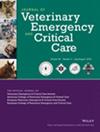Major crossmatch compatibility of rabbit blood with rabbit, canine, and feline blood
Abstract
Objective
To evaluate the major crossmatch compatibility between rabbit recipients, rabbit donors, and the major canine and feline blood types.
Design
Prospective in vitro study in December 2021.
Setting
Academic veterinary teaching hospital.
Animals
Whole blood samples were collected from 11 healthy New Zealand White rabbits (Oryctolagus cuniculus) with no previous transfusion history. Three pigtail segments were acquired from dog erythrocyte antigen (DEA)-1-positive, DEA-1-negative, and feline type A blood units. Whole blood was collected from a healthy type B blood donor cat.
Interventions
Blood from each rabbit recipient underwent a major crossmatch using standard tube crossmatch methodology with itself and the following donor blood types: rabbit, DEA-1-positive, DEA-1-negative, feline type A, and feline type B.
Measurements and Main Results
Self-crossmatches and crossmatches between rabbit recipients and conspecific donors were negative for hemolysis and agglutination. Crossmatches between rabbit recipients and canine and feline donors yielded no hemolysis but produced varying degrees of macroscopic and microscopic agglutination. Rabbit recipients had 1.4 (95% confidence interval: 1.1–1.8) times the risk of macroscopic agglutination when major crossmatched with canine blood compared to feline blood. No significant difference in agglutination was found between DEA-1-positive and DEA-1-negative or feline type A and type B donors.
Conclusions
These findings support allogeneic blood transfusions between rabbits being highly compatible and suggest rabbits have naturally occurring alloantibodies against both canine and feline red blood cells. However, feline red blood cells had a lower rate of in vitro incompatibility on major crossmatch, suggesting potentially higher in vivo compatibility if an emergency xenotransfusion is needed. Further prospective research is needed to determine if xenotransfusion is associated with a higher incidence of acute and delayed transfusion reactions in rabbits than allogeneic transfusions.

 求助内容:
求助内容: 应助结果提醒方式:
应助结果提醒方式:


